CADILLAC STS 2011 1.G Owners Manual
Manufacturer: CADILLAC, Model Year: 2011, Model line: STS, Model: CADILLAC STS 2011 1.GPages: 528, PDF Size: 4.96 MB
Page 231 of 528

Black plate (45,1)Cadillac STS Owner Manual - 2011
-(Defog): This mode clears the windows of fog or
moisture. Air is directed to the windshield and floor
outlets, with some air directed to the side windows
and outboard panel outlets. When this mode is
selected, the system turns off recirculation and runs
the air-conditioning compressor unless the outside
temperature is at or below freezing. If recirculation is
selected while in the defog mode, it is cancelled after
10 minutes.
If there is fogging on the side windows, remain in defog
or defrost mode until they clear.
0 (Defrost): This mode clears the windshield of fog or
frost more quickly. Air is directed to the windshield, with
some air directed to the side windows and outboard
panel outlets. The air-conditioning compressor runs
automatically in this setting, unless the outside
temperature is at or below freezing. Recirculation
cannot be selected while in the defrost mode.
This mode can also cause the fan speed and air
temperature to increase. ^
(Air Conditioning): Press to turn the air conditioning
off. Press AUTO to return to automatic operation. To
limit fogging on the windshield, the air conditioning
compressor cannot be off while in the defrost mode.
h (Recirculation): Press once to select recirculation
mode or twice to select outside air. If in AUTO mode,
press
honce to select recirculation. This mode
recirculates and helps to quickly cool the air inside the
vehicle. It can be used to prevent outside air and odors
from entering the vehicle.
Recirculation is not available in the defrost mode and
shuts off when defog mode is selected. Both of these
features are designed to limit fogging in the vehicle.
If recirculation is selected during defog mode, it
automatically turns off after 10 minutes.
Using the recirculation for long periods of time might
cause the air inside the vehicle to become too dry or
stuffy. To prevent this from happening, after the air in
the vehicle has cooled, press the recirculation button
again to select outside air or press the AUTO button.
4-45
Page 232 of 528
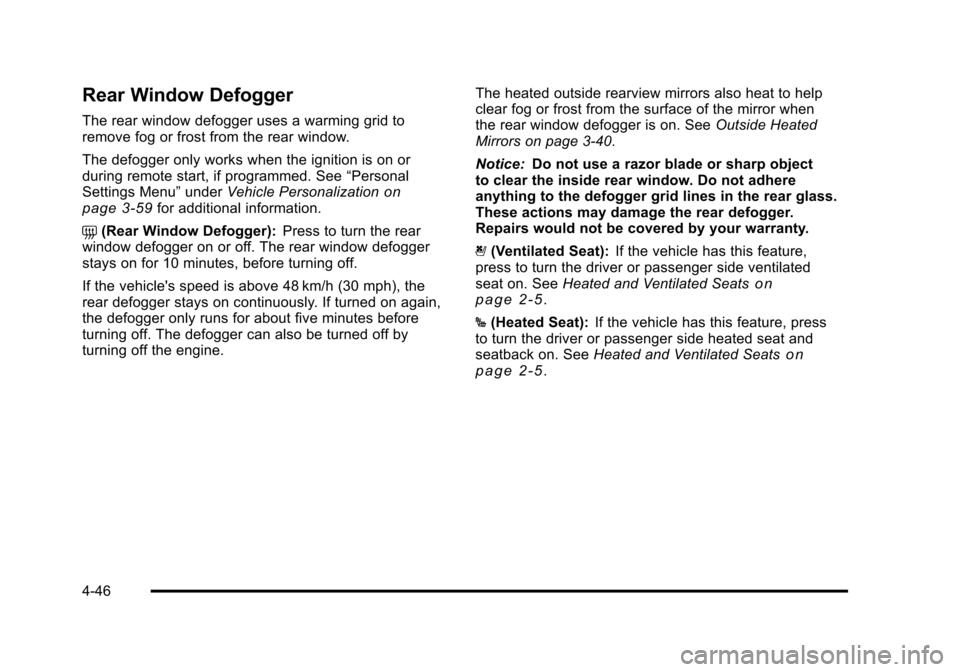
Black plate (46,1)Cadillac STS Owner Manual - 2011
Rear Window Defogger
The rear window defogger uses a warming grid to
remove fog or frost from the rear window.
The defogger only works when the ignition is on or
during remote start, if programmed. See“Personal
Settings Menu” underVehicle Personalization
on
page 3‑59for additional information.
= (Rear Window Defogger): Press to turn the rear
window defogger on or off. The rear window defogger
stays on for 10 minutes, before turning off.
If the vehicle's speed is above 48 km/h (30 mph), the
rear defogger stays on continuously. If turned on again,
the defogger only runs for about five minutes before
turning off. The defogger can also be turned off by
turning off the engine. The heated outside rearview mirrors also heat to help
clear fog or frost from the surface of the mirror when
the rear window defogger is on. See
Outside Heated
Mirrors on page 3‑40.
Notice: Do not use a razor blade or sharp object
to clear the inside rear window. Do not adhere
anything to the defogger grid lines in the rear glass.
These actions may damage the rear defogger.
Repairs would not be covered by your warranty.
{ (Ventilated Seat): If the vehicle has this feature,
press to turn the driver or passenger side ventilated
seat on. See Heated and Ventilated Seats
on
page 2‑5.
J (Heated Seat): If the vehicle has this feature, press
to turn the driver or passenger side heated seat and
seatback on. See Heated and Ventilated Seats
on
page 2‑5.
4-46
Page 233 of 528
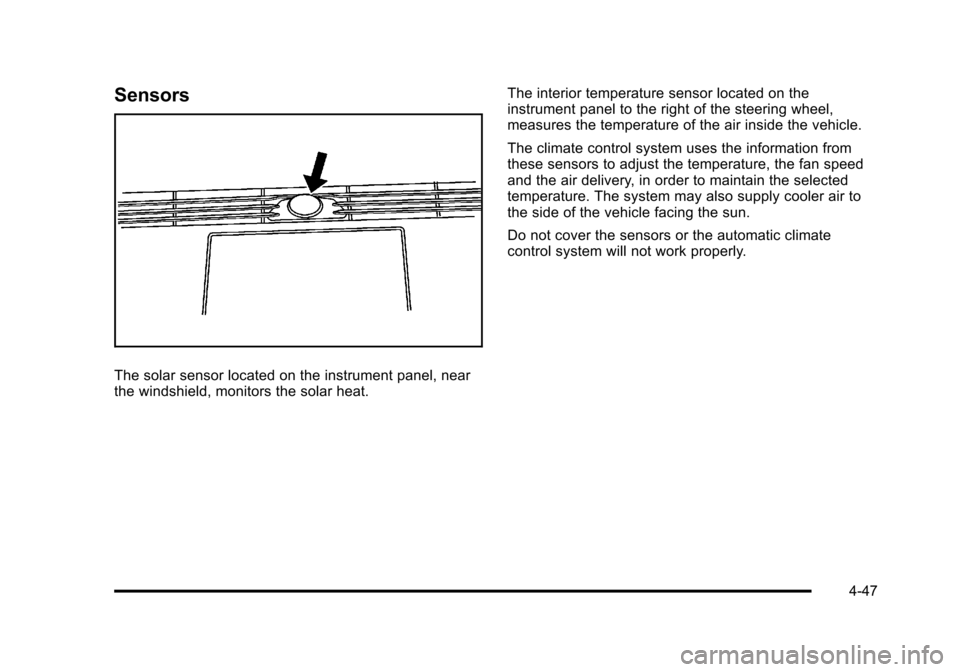
Black plate (47,1)Cadillac STS Owner Manual - 2011
Sensors
The solar sensor located on the instrument panel, near
the windshield, monitors the solar heat.The interior temperature sensor located on the
instrument panel to the right of the steering wheel,
measures the temperature of the air inside the vehicle.
The climate control system uses the information from
these sensors to adjust the temperature, the fan speed
and the air delivery, in order to maintain the selected
temperature. The system may also supply cooler air to
the side of the vehicle facing the sun.
Do not cover the sensors or the automatic climate
control system will not work properly.
4-47
Page 234 of 528
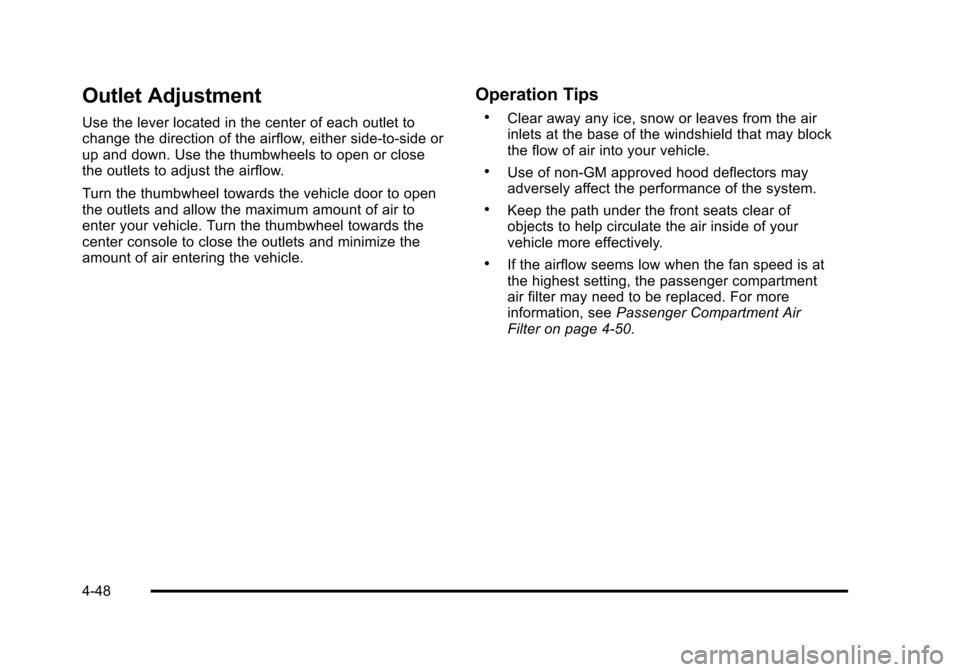
Black plate (48,1)Cadillac STS Owner Manual - 2011
Outlet Adjustment
Use the lever located in the center of each outlet to
change the direction of the airflow, either side-to-side or
up and down. Use the thumbwheels to open or close
the outlets to adjust the airflow.
Turn the thumbwheel towards the vehicle door to open
the outlets and allow the maximum amount of air to
enter your vehicle. Turn the thumbwheel towards the
center console to close the outlets and minimize the
amount of air entering the vehicle.
Operation Tips
.Clear away any ice, snow or leaves from the air
inlets at the base of the windshield that may block
the flow of air into your vehicle.
.Use of non-GM approved hood deflectors may
adversely affect the performance of the system.
.Keep the path under the front seats clear of
objects to help circulate the air inside of your
vehicle more effectively.
.If the airflow seems low when the fan speed is at
the highest setting, the passenger compartment
air filter may need to be replaced. For more
information, seePassenger Compartment Air
Filter on page 4‑50.
4-48
Page 235 of 528
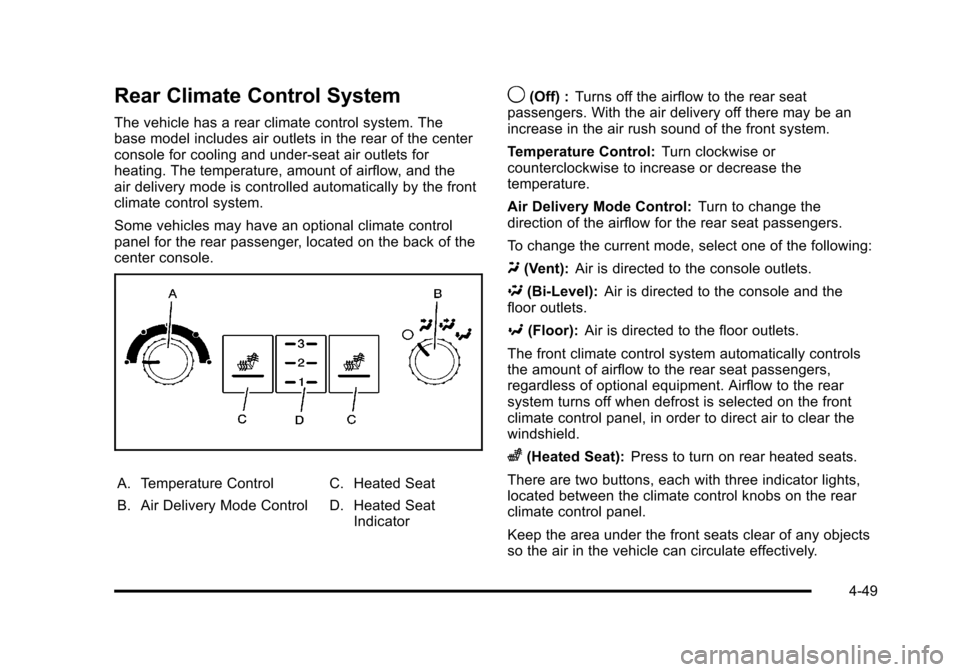
Black plate (49,1)Cadillac STS Owner Manual - 2011
Rear Climate Control System
The vehicle has a rear climate control system. The
base model includes air outlets in the rear of the center
console for cooling and under-seat air outlets for
heating. The temperature, amount of airflow, and the
air delivery mode is controlled automatically by the front
climate control system.
Some vehicles may have an optional climate control
panel for the rear passenger, located on the back of the
center console.
A. Temperature Control
B. Air Delivery Mode ControlC. Heated Seat
D. Heated Seat
Indicator
9(Off) : Turns off the airflow to the rear seat
passengers. With the air delivery off there may be an
increase in the air rush sound of the front system.
Temperature Control: Turn clockwise or
counterclockwise to increase or decrease the
temperature.
Air Delivery Mode Control: Turn to change the
direction of the airflow for the rear seat passengers.
To change the current mode, select one of the following:
Y (Vent): Air is directed to the console outlets.
\ (Bi-Level): Air is directed to the console and the
floor outlets.
[ (Floor): Air is directed to the floor outlets.
The front climate control system automatically controls
the amount of airflow to the rear seat passengers,
regardless of optional equipment. Airflow to the rear
system turns off when defrost is selected on the front
climate control panel, in order to direct air to clear the
windshield.
z(Heated Seat): Press to turn on rear heated seats.
There are two buttons, each with three indicator lights,
located between the climate control knobs on the rear
climate control panel.
Keep the area under the front seats clear of any objects
so the air in the vehicle can circulate effectively.
4-49
Page 236 of 528
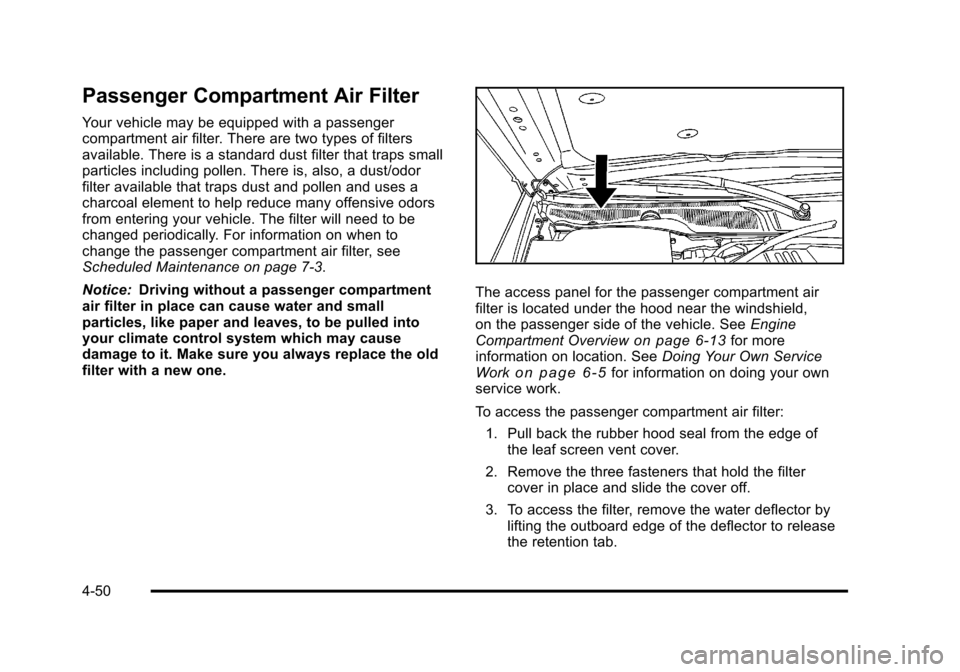
Black plate (50,1)Cadillac STS Owner Manual - 2011
Passenger Compartment Air Filter
Your vehicle may be equipped with a passenger
compartment air filter. There are two types of filters
available. There is a standard dust filter that traps small
particles including pollen. There is, also, a dust/odor
filter available that traps dust and pollen and uses a
charcoal element to help reduce many offensive odors
from entering your vehicle. The filter will need to be
changed periodically. For information on when to
change the passenger compartment air filter, see
Scheduled Maintenance on page 7‑3.
Notice:Driving without a passenger compartment
air filter in place can cause water and small
particles, like paper and leaves, to be pulled into
your climate control system which may cause
damage to it. Make sure you always replace the old
filter with a new one.
The access panel for the passenger compartment air
filter is located under the hood near the windshield,
on the passenger side of the vehicle. See Engine
Compartment Overview
on page 6‑13for more
information on location. See Doing Your Own Service
Work
on page 6‑5for information on doing your own
service work.
To access the passenger compartment air filter:
1. Pull back the rubber hood seal from the edge of the leaf screen vent cover.
2. Remove the three fasteners that hold the filter cover in place and slide the cover off.
3. To access the filter, remove the water deflector by lifting the outboard edge of the deflector to release
the retention tab.
4-50
Page 237 of 528
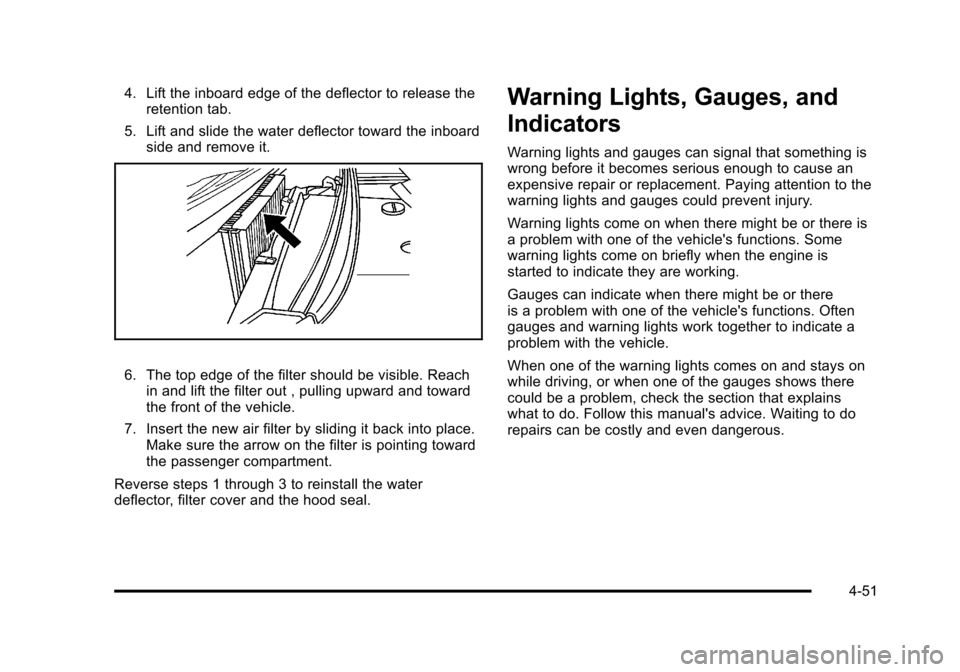
Black plate (51,1)Cadillac STS Owner Manual - 2011
4. Lift the inboard edge of the deflector to release theretention tab.
5. Lift and slide the water deflector toward the inboard side and remove it.
6. The top edge of the filter should be visible. Reachin and lift the filter out , pulling upward and toward
the front of the vehicle.
7. Insert the new air filter by sliding it back into place. Make sure the arrow on the filter is pointing toward
the passenger compartment.
Reverse steps 1 through 3 to reinstall the water
deflector, filter cover and the hood seal.
Warning Lights, Gauges, and
Indicators
Warning lights and gauges can signal that something is
wrong before it becomes serious enough to cause an
expensive repair or replacement. Paying attention to the
warning lights and gauges could prevent injury.
Warning lights come on when there might be or there is
a problem with one of the vehicle's functions. Some
warning lights come on briefly when the engine is
started to indicate they are working.
Gauges can indicate when there might be or there
is a problem with one of the vehicle's functions. Often
gauges and warning lights work together to indicate a
problem with the vehicle.
When one of the warning lights comes on and stays on
while driving, or when one of the gauges shows there
could be a problem, check the section that explains
what to do. Follow this manual's advice. Waiting to do
repairs can be costly and even dangerous.
4-51
Page 238 of 528
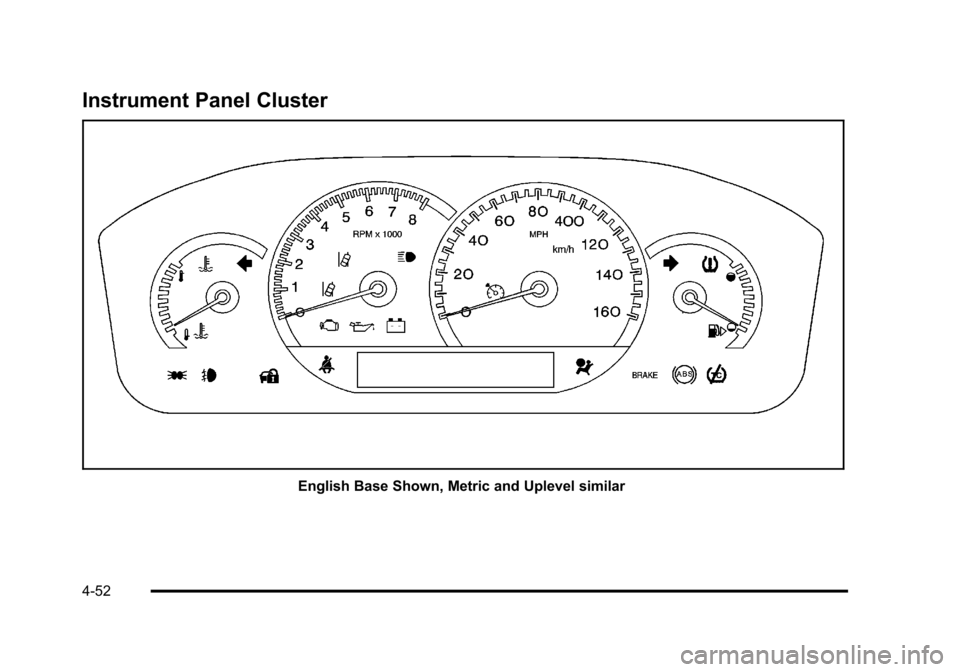
Black plate (52,1)Cadillac STS Owner Manual - 2011
Instrument Panel Cluster
English Base Shown, Metric and Uplevel similar
4-52
Page 239 of 528
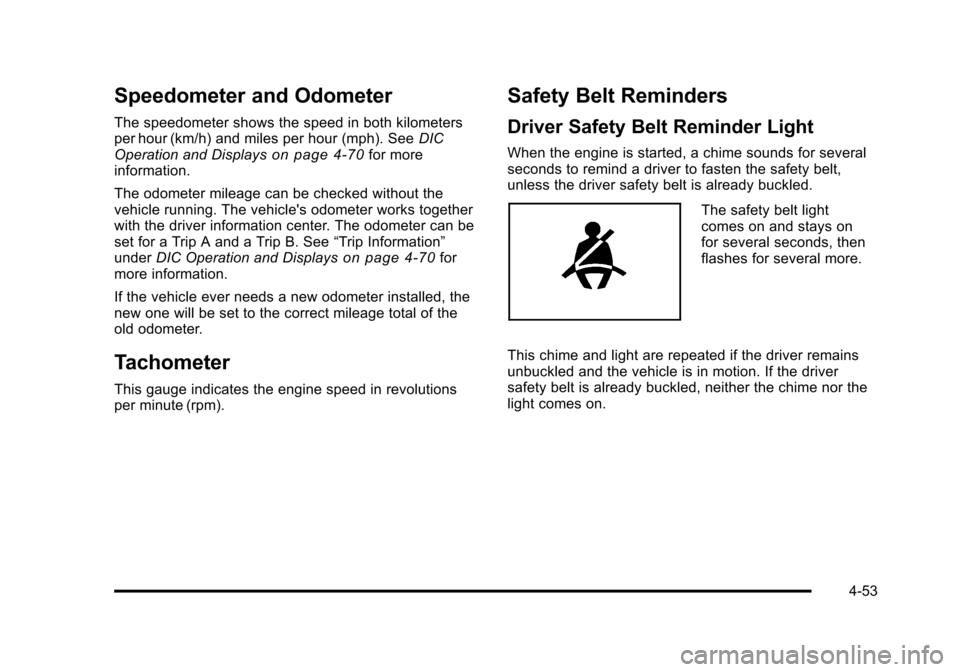
Black plate (53,1)Cadillac STS Owner Manual - 2011
Speedometer and Odometer
The speedometer shows the speed in both kilometers
per hour (km/h) and miles per hour (mph). SeeDIC
Operation and Displays
on page 4‑70for more
information.
The odometer mileage can be checked without the
vehicle running. The vehicle's odometer works together
with the driver information center. The odometer can be
set for a Trip A and a Trip B. See “Trip Information”
under DIC Operation and Displays
on page 4‑70for
more information.
If the vehicle ever needs a new odometer installed, the
new one will be set to the correct mileage total of the
old odometer.
Tachometer
This gauge indicates the engine speed in revolutions
per minute (rpm).
Safety Belt Reminders
Driver Safety Belt Reminder Light
When the engine is started, a chime sounds for several
seconds to remind a driver to fasten the safety belt,
unless the driver safety belt is already buckled.
The safety belt light
comes on and stays on
for several seconds, then
flashes for several more.
This chime and light are repeated if the driver remains
unbuckled and the vehicle is in motion. If the driver
safety belt is already buckled, neither the chime nor the
light comes on.
4-53
Page 240 of 528
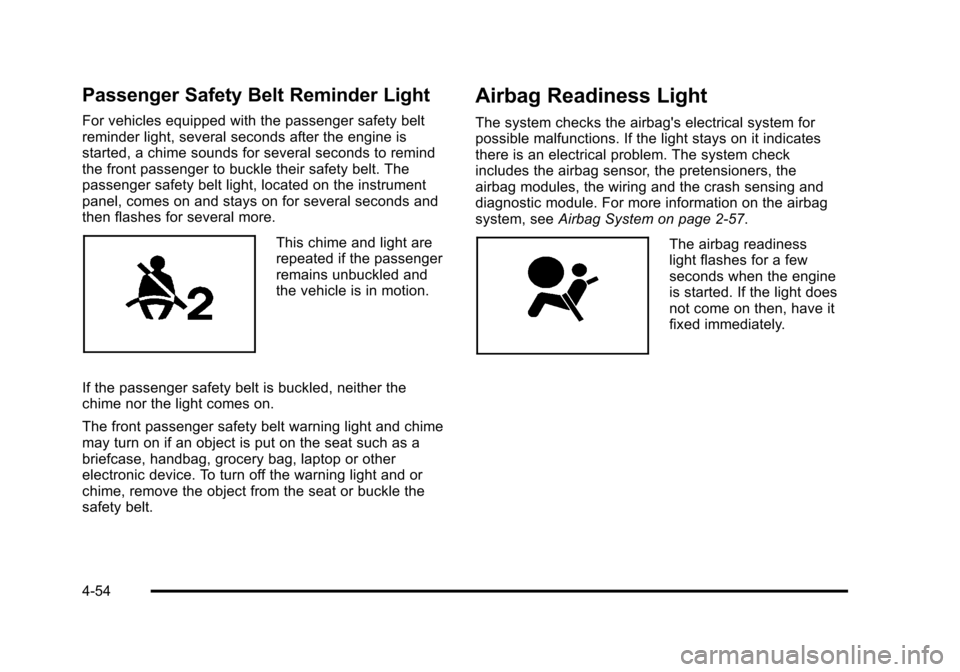
Black plate (54,1)Cadillac STS Owner Manual - 2011
Passenger Safety Belt Reminder Light
For vehicles equipped with the passenger safety belt
reminder light, several seconds after the engine is
started, a chime sounds for several seconds to remind
the front passenger to buckle their safety belt. The
passenger safety belt light, located on the instrument
panel, comes on and stays on for several seconds and
then flashes for several more.
This chime and light are
repeated if the passenger
remains unbuckled and
the vehicle is in motion.
If the passenger safety belt is buckled, neither the
chime nor the light comes on.
The front passenger safety belt warning light and chime
may turn on if an object is put on the seat such as a
briefcase, handbag, grocery bag, laptop or other
electronic device. To turn off the warning light and or
chime, remove the object from the seat or buckle the
safety belt.
Airbag Readiness Light
The system checks the airbag's electrical system for
possible malfunctions. If the light stays on it indicates
there is an electrical problem. The system check
includes the airbag sensor, the pretensioners, the
airbag modules, the wiring and the crash sensing and
diagnostic module. For more information on the airbag
system, see Airbag System on page 2‑57.
The airbag readiness
light flashes for a few
seconds when the engine
is started. If the light does
not come on then, have it
fixed immediately.
4-54